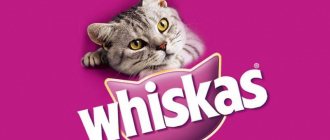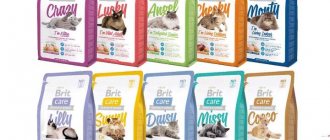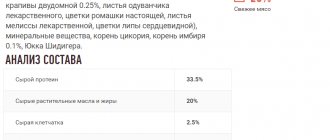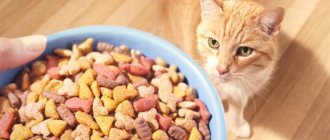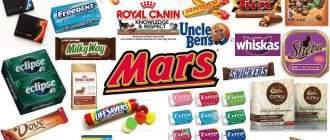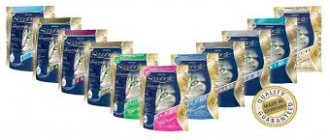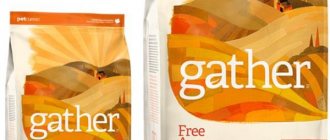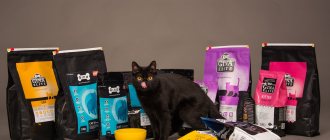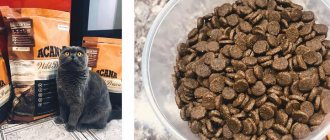July 16, 2016
Wiskas is a brand of cat food produced by Mars ink since 1958. The food first appeared in the UK and was produced by Pedigree Petfoods Ltd. in Melton Mowbray, where other popular foods were also produced: Chappie, Kitekat, Pedigree, Royal Canin. According to various sources, food appeared on our market in 1991. Bright advertising, availability on store shelves and the pleasure with which cats eat whiskey have made it very popular among animal lovers. We decided to figure out whether we are getting healthy food at a low price, or whether the proverb “free cheese is only in a mousetrap” justifies itself here too.
Almost all the reviews about Whiskas that we found on the Russian Internet are negative. Whiskas is blamed for diseases of the urinary system, enlargement of internal organs, diarrhea, dermatitis, cancer and the death of a pet. And the company itself is portrayed as the devil of the cat world, profiting from the lives of its beloved furry friends. However, is this really so? Having asked this question, we had to raise a lot of scientific information. Let's take a point-by-point look at why Whiskas feed is blamed, and what professionals working in the pet business think about it.
- A cat is a carnivore, and whiskey contains everything except meat.
This is true, we must not forget that whiskey is an economy class feed, and in its production, of course, fillet tenderloin will not be used. However, the composition includes slaughterhouse waste and offal, what remains from animals after all the most valuable things have been taken away for people. And there is no need to be afraid of this, as we have already learned above, a cat is a predator, and a predator in the wild does not have to choose. Everything that the prey carcass can digest goes into food: meat, bones, fur. However, this remark is relevant for “yard” breeds. As for purebred animals, you need to be very careful in choosing food, and whiskey would not be included in our recommendations.
- Whiskas contains a lot of vegetable proteins and carbohydrates that are not digested by the cat.
Science has learned to synthesize a complete protein suitable for cats in terms of amino acid composition. And it is its presence in food that replaces meat and makes food cheaper. There's nothing you can do about it, it's such a business. But as for carbohydrates, experts are still arguing about the ability of the cat’s body to absorb it in large quantities. According to recent data, the cat's ability to metabolize starch (carbohydrate) is underestimated.
- Whiskas contains corn or its gluten, and it causes cancer!
Cancer cells feed on carbohydrates, and the presence of corn protein (gluten) in the food does not affect the development of this disease. By the way, brands such as Royal Canin and Hills deliberately leave corn in their feed, and this may indicate its benefits rather than harm. But there is also another opinion that corn is a feed cheapener containing an excess amount of carbohydrate, which leads to obesity, pancreatitis, diabetes and liver disease.
- Whiskas contains flavor enhancers that are harmful to cats and cause addiction.
We are talking about a flavor and aroma additive that makes the food attractive. Here you need to understand that whiskey can be called a “synthetic” food, and of course the cat will not eat tasteless synthetics at will. This additive is contained in almost all feeds, except the most natural ones, and in whiskey in particular there is really a lot of it. Large amounts of the additive can cause food dependence, such that the cat will refuse any other food. It is important that the manufacturer finds the correct ratio of feed and flavoring. After eating them, it is quite difficult to wean your cat off eating such food.
general information
Whiskas is an international brand of cat food. The products are produced by the Petcare division, which is part of the Mars company. This corporation also produces Pedigree dog food, Kitiket and Royal Canin.
Whiskas food began to be produced in 1958. It became the first brand under which several types of ready-made diets with different flavoring additives were developed, which was one of the reasons for the rapid spread of popularity.
The logo is present on all packaging of Whiskas cat food
Whiskas products belong to the economy class. This means that the proportion of meat in the composition is too small, so ready-made diets should not be used for systematic feeding of cats.
Pros and cons of food
The extensive advertising campaign did its job. Now even those who have never kept cats in their home know about the Whiskas brand. However, few people know all the advantages and disadvantages of food. Let's look at them.
The advantages include:
- availability (food is sold in almost all stores);
- contains microelements and vitamins;
- low price;
- a wide range of feeds;
- satiety.
There are much more disadvantages. Among them are:
- the composition contains chemical impurities such as ethoxyquin, butylated hydroxyanisole, butylated hydroxytoluene, E 250;
- the dubiousness of nutrients that are based on meat and plant components;
- food develops addiction in cats;
- it is possible to develop cancer and the appearance of kidney stones due to regular use of the product;
- the meat content in the composition is negligible - only 4%;
- the food contains a large amount of soy, flavorings, preservatives, flavor enhancers and artificial colors;
- negative brand reputation (most reviews from both veterinarians and buyers are negative).
Important! Most diseases of the immune system of cats occur due to the influence of carcinogenic substances that accumulate in the body after consuming artificial food.
Types of Whiskas feed
The company produces 4 types of food: for kittens (from 1 to 12 months), for adult cats (from 1 to 7 years), for older animals (over 7 years) and for sterilized pets. Additionally, they produce products from the “Appetizing Mix” line. They produce both spiders and granulated dry food.
The company is ready to offer many different types of food, but in reality there are no significant differences between them
The lines contain only everyday ready-made diets. There are no medicinal feeds. The composition of different products from the same line differs slightly, so it is not advisable to consider the list of ingredients for each ready-made diet.
Kitten food
The line of food for kittens includes spiders and pads with filling. The first option is better, because it is easier for animals to digest a wet product.
Dry food
Whiskas pads for kittens with carrots, turkey and milk are suitable for animals from 2 to 12 months. This is due to their texture and relatively high fat content. It is not recommended to give dry food to small kittens under 2 months, as the dense consistency will cause digestive upset. As a last resort, the granules are first soaked so that the stomach and mouth are less injured by dry pieces. After 12 months, it is recommended to switch your pet to a different diet so as not to cause the development of obesity.
Cardboard packaging is not completely sealed and allows air to pass through, so this is a controversial decision
The composition includes the following ingredients:
- Wheat flour;
- animal flour: poultry meal, turkey meal (at least 4% turkey in yellow, brown and red granules), meat and bone meal;
- rice;
- protein plant extracts;
- animal fat;
- sunflower oil;
- Brewer's yeast;
- vegetables (including carrots at least 4% in yellow, brown and red granules);
- dairy products (including milk powder, minimum 4% in pillows);
- vitamins;
- minerals and taurine.
The manufacturer claims the following benefits of the formula:
- Strengthening the immune system. The composition contains zinc and vitamin E, which help the kitten’s body synthesize its own antibodies after the loss of maternal antibodies obtained with milk.
- Improving the condition of coat and skin. Zinc, vitamins A and E, as well as omega-6 unsaturated fatty acids help increase the production of skin secretions. The lipid film retains moisture in the skin and acts as a lubricant, enhancing the shine of the coat.
- Strengthening vision. Taurine and vitamin A promote normal organ development and prevent the development of eye pathologies.
- Improved bone health. Calcium and phosphorus strengthen the musculoskeletal system. The risk of fracture is reduced.
- Normalization of digestion. Plant ingredients (cereals and carrots) contain fiber, which enhances peristalsis and prevents constipation.
- Cleansing the oral cavity. Dry granules help remove plaque and prevent the formation of tartar.
There are 2 packaging options: 350 g and 1.9 kg. Large packages are more economical, but with slow consumption, the food will begin to deteriorate due to contact with air. For small kittens, it is more advisable to purchase packages of 350 g.
I would not give my kitten this food. I am personally familiar with cases where animals developed pancreatitis after such feeding. Childhood is an important period for a kitten’s body. At this time, the formation of many internal systems is completed, so the animal requires enough nutrients. There are too few of them in Whiskas products. The balance is artificially brought to normal with the help of mineral supplements, fats and vegetable protein, but in fact the nutritional value is low. There is almost no meat. This is the same as feeding a cat machine oil, calfskin and millet: it looks like there are carbohydrates, proteins and fats, but there is zero benefit.
Wet food
Wet food can be given to animals from 1 month. The increased water content and soft consistency facilitate digestion. The line contains the following products:
- lamb stew;
- chicken stew;
- salmon stew;
- veal jelly;
- turkey jelly;
- chicken pate.
Feeds differ in texture. Ragout consists of pieces of meat with a liquid sauce. The gravy in jelly is thicker. The paste is homogeneous in consistency.
It’s easier for kittens to eat wet food because it’s easier to chew it with their baby teeth
The composition differs slightly, so for example, consider the list of ingredients for chicken stew. The food contains the following components:
- meat and offal (including chicken at least 4%);
- cereals;
- vegetable oil;
- taurine;
- vitamins;
- minerals.
The manufacturer claims the following advantages:
- The presence of vitamin E in the composition. Tocopherols are essential for the proper functioning of the immune system and the maintenance of optimal skin and coat condition. Vitamin E is involved in the synthesis of new cells and enhances the production of sebaceous secretions.
- Presence of calcium. The mineral helps strengthen bones and teeth.
- High content of zinc and omega-6. The substances cause increased activity of the excretory glands, which protects the skin from drying out and peeling.
- The presence of taurine and vitamin A. Useful substances are necessary for the formation of visual organs.
Wet food for kittens contains more fat, so it can be used to feed malnourished animals.
Cats are not able to synthesize taurine from other compounds on their own, so it must be present in the food.
Spiders weigh 85 g. Sometimes you can find packages of several packs on sale. This allows you to save a little due to a discount for bulk purchases.
Large packages are more common in online stores
Not the best option for a kitten. The manufacturer suggests giving ready-made diets from 1 month, i.e. practically as the first complementary food. Once, due to my own inexperience, I offered such food to a street kitten I took home. He started vomiting. If there are no other options, it is advisable to give spiders to animals only after 2 months, when digestion has improved a little. Until this point, even a single feeding can cause serious disruption, including dehydration due to vomiting and diarrhea. In some cases this leads to death.
Food for adult cats
Food for adult cats is available in 2 versions: wet and dry. It is recommended to give granules only to those animals that independently comply with the drinking regime and do not suffer from diseases of the genitourinary system. A cat should consume at least 20–40 ml per 1 kg of weight per day.
Dry food
The company produces pate pillows in 3 flavors: salmon, chicken and turkey, and beef and rabbit. Generally speaking, the food is suitable for healthy animals from 1 to 7 years old.
The range of wet and dry Whiskas food for adult animals is the widest
The composition of different products is identical. Minor differences are associated with the types of meat used. For example, consider the composition of pillows with beef and rabbit meat. The list of ingredients contains the following components:
- Wheat flour;
- animal flour: poultry meal, beef meal, lamb meal, rabbit meal (beef, lamb and rabbit at least 4% in red-brown granules);
- plant protein extracts;
- cereals;
- animal fats and vegetable oils;
- dried chicken and pork liver;
- Brewer's yeast;
- beet pulp;
- carrot;
- mineral and vitamin mixtures.
The benefits declared by the manufacturer are the same: the presence of vitamins and minerals in the composition, strengthening the immune system and bones, supporting the development of the visual organs, etc. There are 3 packaging options: packages of 350 g, 800 g, 1.9 kg and 5 kg.
One day, a neighbor who had 2 cats at home came to me for advice. She said that the pets were in terrible condition and asked for help. The animals' fur fell out in clumps, leaving bald patches with itchy red spots. The skin came off in layers. There was no dandruff only on the stomach. I advised her to contact a veterinarian, but during the conversation it turned out that the neighbor gives her cats Whiskas food. She was very surprised to find out that this was one of the worst products, and the next day she began switching the animals to a super premium diet. During the examination, the veterinarian said that this was a severe allergy and supported the decision to change the food. After 2 weeks, the cats stopped scratching themselves until they bled, and the spots disappeared. After a month, the wounds healed, and hair began to grow on the bald areas.
Wet food
Based on consistency, wet food is divided into stews, pates, jellies, cream soups and mini-fillets. The cream soup additionally includes plant-based dry cream. The mini fillet has a consistency similar to stew. Flavorings include salmon, trout, veal, beef, turkey, etc.
There are no fundamental differences in composition, so for example, let’s look at jelly with turkey and vegetables. The list of ingredients contains the following items:
- meat and offal (including turkey at least 4%);
- vegetables (carrots at least 4%);
- cereals;
- taurine;
- vitamins;
- minerals.
The benefits declared by the manufacturer are the same. One spider weighs 85 g.
On average, pets need 2-3 spiders to get enough food
I am glad that the composition contains animal products in the first place, but I would not rush to boldly call this a full-fledged plus. Once upon a time, a friend of mine worked at one of the factories producing economy-class feed. She said that if people knew what was included in such products, they would never buy ready-made diets in their lives. I don’t know whether to believe it or not, but the general definitions (“meat,” “offal,” “turkey,” “vegetables,” and “grains”) are confusing. Among the same offal there may be liver, kidneys or hearts, as well as bladders or intestines. Many super-premium and holistic food manufacturers specify a specific type of ingredient. In the case of Whiskas products, everything is not so transparent. This makes you think: if everything in the composition was good, the manufacturer would have nothing to hide.
Food for older cats
The line of food for older cats is smaller: it contains only one granular product and 3 types of spiders. Ready-made diets are suitable for animals over 7 years old.
Dry food
The only representative is pillows with poultry pate. Theoretically, the porous texture with soft contents helps reduce stress on the teeth. The pet has to make less effort to break the granule, which partially prevents damage to the enamel and roots.
Your pet does not need to be switched to a different diet if it receives vitamin and mineral supplements as prescribed by a veterinarian
The food contains the following ingredients:
- Wheat flour;
- animal meal: poultry meal (minimum 4% in brown granules), meat and bone meal;
- protein plant extracts;
- rice;
- animal fat;
- sunflower oil;
- Brewer's yeast;
- vitamins;
- minerals and taurine.
The manufacturer claims that the composition contains glucosamine, which is necessary to maintain healthy joints. One of the advantages is a special formula to improve appetite, but the composition of the product is identical to others. Buyers can only guess what exactly keeps animals interested in the product. Most likely, these are artificial flavors that do not provide any benefit, but can cause harm. Theoretically, the caloric content of the food is lower than that of others, since weight maintenance is stated among the benefits, but the manufacturer does not disclose the nutritional value of the product on the website.
Large packages are not available for sale. The food is produced in small cardboard packs of 350 g.
The lack of specifics and general formulations cause distrust in the company. For example, the manufacturer claims that dry food helps clean teeth from plaque. For this purpose, special porous granules are produced that do not crack when pressed with fangs, but fall inside. Because of this feature, surrounding particles clean the surface of the tooth down to the roots. I specifically conducted a small experiment. In the case of Whiskas food, nothing like this was observed: the cat simply bit into the granules while eating. Perhaps the manufacturer is not lying, because such a product also cleans the tips of the fangs, but it is difficult to call this complete care. To prevent the cat from losing teeth in old age, owners will have to additionally use a special brush for animals.
Wet food
The company produces 3 types of wet food for older animals: chicken stew, lamb stew and veal pate. The composition is almost identical, however, in the pate the proportion of the declared meat component is much higher compared to analogues: 24% versus 10% and 4% in different types of stews. It also contains no grains.
It is recommended that older animals be given wet food to reduce the stress on the teeth and gastrointestinal tract.
For example, consider the composition of lamb stew. The list of components mentions the following items:
- meat and offal (including lamb at least 4%);
- cereals;
- vegetable oil;
- taurine;
- vitamins;
- minerals.
The benefits are the same as other foods. The only fundamental difference is the presence of glucosamine and components (possibly flavorings) to enhance appetite.
Food for sterilized animals
The line contains only dry food. There are 2 flavors available to choose from: chicken and veal.
The absence of wet food in the line for sterilized animals is a questionable decision
For example, consider the composition of chicken feed:
- Wheat flour;
- animal flour (including chicken flour at least 4% in brown granules);
- protein plant extracts;
- rice;
- animal fats and vegetable oils;
- dried chicken and pork liver;
- Brewer's yeast;
- vitamins and minerals.
The manufacturer states that the finished diet contains the optimal ratio of substances to maintain the health of the urinary system. However, the company does not specify what exactly helps maintain the normal state of internal organs. The composition does not differ from similar products. Perhaps the special feature of the food is its low salt content, but when it comes to the health of your pet, you don’t want to guess, but to know for sure. The product is available in packages of 350 g, 1.9 kg and 5 kg.
I don’t know how food for sterilized animals differs from regular food, but I suspect it’s only in name. I personally know of 2 cases where cats developed urolithiasis after such a diet, and I regularly encounter negative comments and reviews. After my pet was neutered, the veterinarian told me what the diet should be. If this is a ready-made diet, then it should contain a minimum of salt (only for the natural needs of the body and to preserve moisture), the presence of natural preservatives and additives to normalize the acidity of urine is welcome. It is advisable to prefer wet food, since the liquid promotes timely emptying of the bladder and prevents the increase in the saturation of urine with minerals. This prevents the formation of stones. Whiskas dry food does not meet these criteria, so it is not recommended to give it to animals after sterilization or castration.
Line “Appetizing mix”
The line includes 4 types of wet food: chicken and duck with cheese sauce, lamb and beef with cream sauce, poultry and beef with tomato jelly and shrimp with salmon and cream sauce. The composition is almost identical. The main difference is the flavoring additives. Depending on the type of food, it can be cheese or tomato powder, as well as a milk-containing product.
Tomato jelly with beef and poultry contains the following ingredients:
- meat and offal (including poultry and beef);
- cereals;
- vegetable oil;
- tomato powder;
- taurine;
- vitamins;
- minerals.
The “Appetizing Mix” line of food differs from similar products only in the presence of flavoring additives and, possibly, the percentage of components. While other ready-made diets indicate minimum contents of certain ingredients, these products do not contain specific information.
Composition analysis
The food is almost identical in composition, so it is enough to consider 1-2 samples. As an example, let’s look at the list of ingredients for pads with beef and rabbit meat for adult cats:
- Wheat flour;
- animal flour: poultry meal, beef meal, lamb meal, rabbit meal (beef, lamb and rabbit at least 4% in red-brown granules);
- plant protein extracts;
- cereals;
- animal fats and vegetable oils;
- dried chicken and pork liver;
- Brewer's yeast;
- beet pulp;
- carrot;
- mineral and vitamin mixtures.
Wheat flour comes first. This is a source of plant proteins and carbohydrates, which the cat practically does not need. Most of the nutrients are not absorbed by the pet’s body, since carnivores have a short gastrointestinal tract adapted to digesting products of animal origin. Wheat can be harmful to a cat's health. It relatively often causes the development of allergies.
The manufacturer claims that the food contains no dyes, but this is hard to believe
The only animal products included are flour and liver. The share of the latter is comparable to the amount of brewer's yeast and vegetable oil, so it can be ignored. Animal flour is in 2nd place. It is obtained not only from pure meat, but also from industrial waste, feathers, bones, scales, etc. Such a source of protein cannot be called high-quality. In addition, the share of rabbit, lamb and beef does not exceed 4%. Judging by the manufacturer's clarification, these varieties are contained only in red-brown granules. The rest contain cheaper birds.
In total, the proportion of plant protein extracts, wheat flour and cereals is much higher than the amount of animal flour. This reduces the nutritional value of the product for cats.
Animal fats and vegetable oils help bring the nutrient balance to optimal. Unfortunately, the manufacturer does not indicate the specific type of products, so the buyer can only guess about their quality. The same goes for cereals.
The advantages include the presence of carrots and beet pulp. These are sources of fiber that aid digestion and promote the movement of stool. Coarse plant fibers cleanse the intestinal walls and remove rotting food particles.
Let's look at the composition of wet food for kittens (chicken stew):
- meat and offal (including chicken at least 4%);
- cereals;
- vegetable oil;
- taurine;
- vitamins;
- minerals.
The clarification about the minimum share of chicken is alarming, because 4% is very little for wet cat food. It is not specified what other sources of animal protein the product includes. The need for the presence of grains in a ready-made diet is questionable, so their presence in such quantities (2nd position) is a minus. Vegetable oils can be useful provided that high-quality raw materials are used and in a relatively small volume. The percentage of components and their type are not specified, so one should suspect the worst. Low-quality oils cause digestive upset and increase the load on the pancreas. Taurine, vitamins and minerals are standard feed additives. Their proportion and type have not been specified, so it is impossible to draw any conclusions.
Whiskas feed is more reminiscent of grain mixtures in composition. Such products are definitely not suitable for cats. Buyers largely have to guess about the composition of feeds. If you compare Whiskas with any product of at least super-premium class, the difference will be obvious: there are specific items in the list of ingredients. The best dry food in the entire line can be called a product for kittens. The difference is that it contains a higher proportion of rice than protein plant extracts (presumably by-products), but it also often causes nausea in animals. My colleague once tried to feed a malnourished adult cat taken from the street with it. The animal suffered from vomiting until it was switched to baby food and Acana food.
Advantages and disadvantages of food
The disadvantages of feed include the following factors:
- Low content of meat ingredients. If it is dry food, they are below the first position. If wet, a large proportion of the composition is occupied by water and grains.
- Lack of percentage of components. There is no specific information available, so buyers cannot be sure of the quality of the food.
- Using low quality ingredients. If these are cereals, then they are not whole or even presented as a protein extract. Flour is used as meat products.
- Lack of specific information. The manufacturer does not indicate the ingredients used. This reinforces confidence in using low-quality components. Additionally, this causes inconvenience for cat owners prone to allergies.
- Veiled attempts at deception. For example, information about cleaning teeth with granules is only partially reliable. You can’t find fault here: any dry food removes some of the plaque from the ends of your teeth. However, a real preventive product should also clean the area near the roots. Buyers perceive these assurances as a guarantee of high-quality plaque removal.
- No fundamental differences between products. The composition of the feed is almost identical. Most often, the difference lies in the flavoring additives.
- Presence of the pesticide pirimiphos-methyl in trace amounts. The violation was discovered during testing by Roskachestvo. Pirimiphos-methyl is an insecticide used on cereals. In small quantities, the toxin increases the load on the stomach, liver and kidneys; in large quantities, it can cause cardiac arrest.
The angular pellets can cause your cat to accidentally injure the roof of their mouth or gums.
The list of advantages can only include the relative merits of the food. For example, according to the results of the study, the product contains no pests. In reality, all food (including economy class) must meet these requirements, so this is not a reason to be proud. Cats eat Whiskas products with pleasure and often refuse to switch to other ready-made diets, but this may be due to flavorings and flavoring additives.
conclusions
Whiskas is the most popular and highly advertised food. It's a shame that it is of such low quality. Veterinarians unanimously say that it should not be given to cats. And the pets themselves, in most cases, eat the food with great pleasure and get used to it. This can only be explained by the presence of flavorings in the composition, since there is almost no meat in it.
Unfortunately, cats that often eat Whiskas run the risk of developing huge health problems, since the product contains many carcinogens and artificial additives. There will be little benefit from this food. It's better to add money and buy a premium product.
Which is better: Whiskas or Friskis?
To answer the question of which food is better, you need to consider the composition of Friskis products. For example, let's look at the list of ingredients of a dry ready-made diet for adult cats:
- cereals;
- meat and its processed products;
- vegetable processing products;
- vegetable protein;
- fats and oils;
- yeast;
- preservatives;
- minerals;
- vitamins;
- dyes;
- vegetables and antioxidants.
It is impossible to say unequivocally which food is worse. Friskies products also contain dubious ingredients and vague formulations. The share of meat components is also low. There is no fundamental difference in quality.
Friskies food, like Whiskas, belongs to the economy class
The cost of "Friskies" is lower. The price of the pouch is 15–20 rubles. Small (400 g) packages of dry food cost 70-80 rubles, medium (2 kg) - 300-350 rubles, large (10 kg) - 1400-1500 rubles. However, it should be borne in mind that purchasing economy-class products means saving on your pet’s health. Late examination and treatment at the clinic may be more expensive. In addition, low-quality feeds have low nutritional value, so animals require more of them than super-premium or holistic products.
There is such a thing in the world, you most likely know about it exclusively from chocolate bars and you most likely associate it with astronomy. For almost two years of working in the pet business, this word evokes very strong feelings. This company produces the following feeds: Whiskas, Kiteket, Pedigree, Chappie. Although Friscos is produced by the Purina company, its quality is completely similar to Mars food. This is the most popular animal food among ordinary people. The population judges them solely on television advertising (fortunately, these are practically the only foods that are advertised on TV, with the exception of rare promotions), as well as from the experience of their closest acquaintances, therefore, the population considers these foods to be almost one of the most serious in the pet business industry, many they are trusted, and if they are not trusted, it is solely due to distrust of dry food in general. In more professional areas, opinion was developed quite a long time ago, and a completely definite one was developed. (I mean the field of veterinary medicine, professional breeding (breeders, nurseries), the field of trade in pet supplies, just people who are very interested in how to feed animals correctly). The following joke has become established among veterinarians: Martian food is our bread, as long as Mars exists, we will always have work, the day of the death of Mars will be a black day for the entire veterinary industry, it will be the day of the collapse of veterinary clinics.
On behalf of the group Cats... Cats... Kittens... In good hands! MOSCOW
https://vk.com/topic-17296831_30129564
Owners' opinions were divided. Some argue that food should be selected individually, because Whiskas suits some cats better, while Friskies suits others better. Other pet owners say it's best to avoid both products.
Reviews
Before buying Whiskas food, it makes sense to read the reviews.
Elena: “I fed my Vaska only natural homemade food, and then Whiskas pate caught my eye. I’ve heard about this food since childhood, so I decided to try it. To be honest, the food smells sour. The cat ate without any desire. Then I read the reviews on the forums and decided that I definitely wouldn’t buy Whiskas. It contains nothing but waste."
Marina: “I’ve also heard a lot about the composition of Whiskas, but I don’t see anything beyond terrible. My cat has been eating it for two years now. True, I also give her home-cooked food. There are no health problems. Apparently, our case is an exception, since the food suited my little animal perfectly.”
Varvara: “I left my Briton for foster care with neighbors. She clearly instructed what food to give. When I returned a month later, I discovered that my cat had changed a lot. His eyes were swollen, there were small bald spots, and in general he behaved strangely. The neighbors admitted that they fed him Whiskas. I immediately rushed to the vet. He diagnosed an allergy, now we are being treated. And I don’t communicate with my neighbors anymore.”
